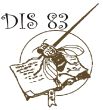
Kacmarczyk, Thadeous. 2000. An aspirator fly trap. Dros. Inf. Serv. 83: 197-198.
|
|
|
|||
An aspirator fly trap.
Kacmarczyk, Thadeous. Division of Natural Sciences, Purchase College, State University of New York, Purchase, N.Y. 10577-1400.
It is often desirable to collect large numbers of flies without etherization. The device shown in Figure 1 was developed in order to collect large volumes of flies (i.e., 0.5-1.0 g) more efficiently. It is a modification of a basic aspirator routinely used to collect newly eclosed Hawaiian Drosophila adults from the sand jars used
|
|
|
Figure 1. Aspirator fly trap. |
for pupation (Spieth, 1972). The basic aspirator consists of a portion of a disposable 10-ml pipet attached to plastic Tygon tubing (3/8 ID ´ 1/16 wall), with some gauze or fine nylon mesh at the interface. The flies enter the device from the cut end of the disposable pipet as mouth suction or a mechanical vacuum is applied at the end of the tubing. The pipet can be heated close to the cut end and curved slightly for ergonomic efficiency. When aspirating a large volume of flies, a regular aspirator can get repeatedly clogged, or the flies can be damaged.
The modification presented here entails the attachment of a Nalgene 30-ml screw-cap vial between the disposable pipet and the flexible tubing to serve as a reservoir. A hole of the appropriate size was
drilled in the lid of the Nalgene
vial in order to snugly fit the end of the disposable pipet. Another hole was drilled in the bottom
of the vial to accommodate the tubing.
A very fine piece of nylon mesh was placed over the end of the tubing
before fitting it into the vial. To
strengthen the connection, a 7-8 cm piece of pipet may be required as an adapter
between the tubing and the mesh. The flies are then aspirated in the same manner as with a traditional
aspirator. However, instead of
repeatedly collecting and blowing out a small number of individuals, the flies
accumulate in the reservoir until the required volume is reached.
The vial is then tapped to remove the flies from the lid area, and
the lid is removed and quickly covered by your thumb.
If you are dexterous, the lid can be immediately replaced with a 15-ml
conical Falcon tube. The vial
is then inverted, and with a slight tap, all the flies end up in the Falcon
tube. Voila! A large volume of unetherized flies collected quickly and painlessly.
Acknowledgments: This was developed in the course of a
project on Hawaiian Drosophila supported
by NSF grant DEB97-29192 to my sponsor Dr. Elysse Craddock.
References: Spieth, H.T., 1972, Dros. Inf. Serv. 48: 155-157.